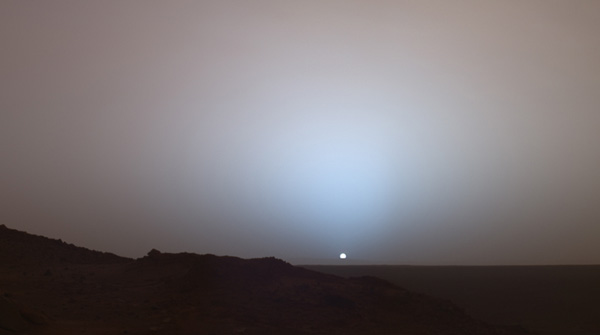|

Sunset over Gusev Crater, captured 19 May 2005, by the Pancam system on the Spirit rover. Like Pancam, the MSL Mastcam system will acquire multispectral color views of geologic and atmospheric features. Mastcam also provides both natural color still and high definition video capability. -- Image Credit: NASA/JPL/Texas A&M/Cornell
Main Objective: To contribute to the characterization and help determine the details of the history and processes recorded in geologic material at the MSL site on Mars.
Science Goals:
- Observe landscape physiography and processes at the MSL site. Mastcam images will be used to determine local topography, geomorphology, and the geologic setting of the MSL site. This contributes to understanding the nature of both past and present geologic processes at the site.
- Examine rocks at the MSL site. Mastcam images will be used to examine and contribute to studies of the texture, morphology, structure, mineralogy, stratigraphy, history, and alteration of rocks encountered by the MSL rover.
- Examine fines at the MSL site. “Fines” is a term that describes all of the sand, silt, and dust on Mars. Mastcam data will be used to study the fines in the Martian regolith (the dirt), including their physical and mechanical properties, the results of rover hardware interaction with the fines, plus the stratigraphy, texture, mineralogy, and depositional processes involved.
- Observe frost and ice at the MSL site. Images from the Viking 2 lander and the rover, Opportunity, showed frost on Mars at middle and equatorial latitudes, respectively. If frost or ice are present at the MSL site, and visible during the day, then Mastcam data will be used to help characterize the texture, morphology, thickness, stratigraphic position, and relation to the regolith of these materials. In addition, if they are present, Mastcam images will be used to examine ice-related geomorphic features, such as patterned ground landforms (e.g., polygons).
- Document atmospheric and meteorologic events and processes. Mastcam will be used to observe clouds, dust-raising events (dust storms, gusts, and dust devils), the properties of suspended aerosols (dust and ice crystals high in the atmosphere), and, using its video capability, the transport of fines by wind.
- Facilitate other MSL science. Mastcam data will be used to help the MSL science teams decide where to collect samples, where to drive the rover to next, and to help characterize the nature of the materials the other instruments will examine.
|




